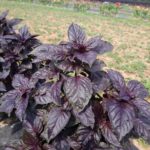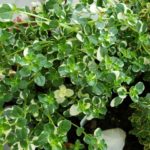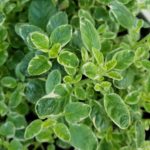Culinary herbs have fascinated and filled my senses through the decades, the way airy globe-shaped clusters of dill flowers seem to frolic in a light breeze, the clean camphor aroma sensed from brushing against a stand of rosemary, or the surprising white -colored flowers peeking through long-stemmed oregano. I do value the outstanding flavor herbs bring by helping us use less salt, fat and sugar in our diets, a practice that follows the Texas A&M AgriLife Extension Service Path to Plate initiative, a program helping consumers understand how their food choices impact their health. These multi-sensory encounters expanded my palette to appreciate herbs not only for the variety of taste but also for their visual appeal. One garden design trend we have seen promoted in popular culture is edible landscaping, and we can certainly use herbs as a design feature not only for their function and also for their form. Like ornamental plants, culinary herbs come in various heights, leaf texture, and leaf and flower color. Several varieties that I will focus on include basil, and variegated thyme and oregano.
Basil (Ocimum basilicum) is a semi-woody annual used for its aromatic leaves. Cultivars can be bold in stature and flavor and exhibiting large, sweet anise-flavored leaves measuring 3-inches long by 2-inches wide. Most of these types are generically names with titles like ‘Sweet Basil’ or ‘Green-leaf Basil’, and an exception is one named ‘Genovese’. ‘Genovese’ is a tad stronger than ‘Sweet’, and varieties like long-leaved ‘Siam Queen’ are bold and more pungent. Then there are purple-colored varieties of basil that can provide great contrast in the landscape with varieties such as ‘Purple Ruffles’, ‘Dark Opal, or ‘Purple Petra’. Consider height as some of the basil’s previously described provide a canopy up to 2-feet. On the opposite end of the spectrum is small-leaved, uniform and compact basil titled ‘Boxwood’ coming in at 10-inches in height and more appropriate in the edible landscape as a garden border.
Thyme is an evergreen sub-shrub, some varieties raising up to 20-inches while others grow in a creeping, mat-forming habit. Leaves are very small, typically no more than one-eighth inch wide with numerous oil glands that offer a pleasingly pungent smell. Thyme should be planted in full sun with well-draining soil and will rot in place if left in saturated soils. Thyme offers a distinctive peppery taste and can be used either fresh or dry in soups, stews, stuffing and poultry dishes. According to the University of Illinois Extension, its flavor and fragrance will remain with long, slow cooking. One variety offering outstanding contrast is Broadleaf Thyme (Thymus pulegioides) variety ‘Foxley’. This variety has bright white variegation on well-rounded leaves, and has the potential to mound up to 12-inches. Planted in the landscape, you can combine Foxley with variety Silver Queen Lemon Thyme (Thymus citriodorus), preferred for its rich lemon-scented leaves and pale-lilac colored flowers.
Another herb with cream-colored leaf margins is Variegated Oregano (Origanum vulgare), growing up to 12-inches tall by 2-feet wide, offering white flowers and tasting milder than common oregano.
Following national and state guidelines for health and safety during the pandemic, we can continue to explore the beauty of nature in our own backyard and learn from online resources. I am streaming live presentations online with ‘Basil Bounty’ sponsored by Keep Pearland Beautiful, and ‘Herbs for Brazoria County’ sponsored by Angleton Parks and Recreation Department. Find out more about these programs with links from our county website: brazoria.agrilife.org. I invite you to share your ideas and successes in your garden by browsing online to my Facebook webpage: facebook.com/horticulturiststephenb, as well as keeping up with programs and activities promoted from Brazoria County AgriLife Extension. Let the spice of herbs bring flavor and color to you and I’ll see you in the garden.



